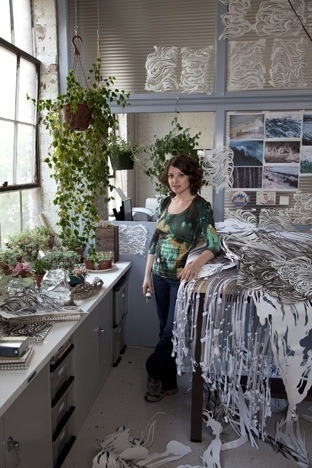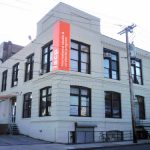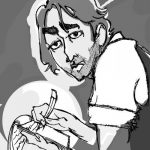Meet a NYFA Artist: Mia Pearlman
NYFA speaks with Fellow in Crafts/Sculpture and 2011 Robert Sterling Clark Visual Arts Space Award Recipient Mia Pearlman.
NYFA: What is your studio or workspace like?
MP: My “permanent” studio, which I’ve had for years, is in Brooklyn and is full of plants—I collect succulents, the weirder the better—art, art supplies, take-out menus, and more plants. This past year I’ve had a studio at the Marie Walsh Sharpe Space Program in DUMBO, which came through my NYFA grant as a separate fellowship from the Robert Sterling Clark Foundation. It couldn’t have come at a better moment, because I’m in the process of creating a GIGANTIC installation for a show at the Renwick Gallery at the Smithsonian American Art Museum this July, and I didn’t have enough space in my usual studio to make the pieces and mock it up (which is very unusual for me). The first thing I did when I got the key was to measure the space between the fluorescent lights that hang from the ceiling of the studio. It turned out to be the exact width of the window niches where I’m installing at the Renwick. How do you like that for fate?
NYFA: Can you tell us a bit about your experiences growing up? How does your background inform your work?
MP: I’m a born and bred New Yorker—I grew up in Northern NJ and Manhattan, and have basically lived here my entire life. It’s possible that my work is just a reflection of my frustrated desire to be closer to nature! I grew up in a very creative, intellectual family that schlepped me to museums and concerts and the ballet, and to nature, all of which probably influenced me in ways that can’t really be described. I never really know what my work is truly about until long after I make it, and usually I realize it has to do with something I saw or experienced many years prior. Not that long ago I was going through old papers and unearthed a long-forgotten folder of incredibly delicate black cutouts that my father brought me back from China in 1980. I was just a small child at the time, but I remember raptly studying these lattice pandas and pagodas and marveling at their intricacy. Is that why I cut paper now? Who knows, but it sure was interesting to realize this little travel souvenir is an important part of my artistic DNA.
My family has always been 100% supportive of me and my work, which is priceless. And of course, being from here is an advantage itself. New Yorkers are a tough bunch, and if there’s any place where only the strong survive, it’s the art world.
NYFA: Who or what is influencing you the most strongly right now?
MP:This new piece I’m making for the Renwick is a big step for my work, in terms of form and content, and deals with water as a subject and metaphor instead of weather. I’ve been looking at a lot of Chinese and Japanese art, because I’m interested in the way nature can be very stylized or naturalistic, often in the same image. I’ve been deeply influenced by the screen painting Waves at Matsushima by Tawaraya Sōtatsu, which I found in a book but happens to be in the collection of the Freer, also part of the Smithsonian. Soon after I discovered it, the Japanese tsunami happened, and the images of water and destruction were eerily similar. I’m interested in the idea of simultaneity, and showing in one moment the simultaneous passage of time, from things like the tsunami that move super fast, to incredibly slow forming phenomena like stalactites. I’ve also been reading a lot about the Tao, various cosmologies of the universe, and the theoretical physics concept of the “multiverse,” among other things. The Taoist concept of Yin and Yang has been a huge influence in my Renwick piece.
NYFA: What is your psychological and emotional relationship with your work like?
MP: If I don’t work in the studio for several days, I get very grumpy, I can tell you that. My work is very intuitive, and I think the studio is where I process things. But I really try to not to over-identify with my work. As I tell people, just because you take your work seriously doesn’t mean you have to take yourself seriously. It doesn’t have to be that precious. That’s why I like working with paper and making things that are ephemeral. I can have fun with it.
NYFA: Does each work carry its own intention, tone, mood, or is there a particular state that you hope your work will catalyze in a viewer?
MP: My main goal is to provoke a visceral response in the viewer. My work is about invisible forces larger than us, beyond our control—these could be weather or the stock market or cancer or whatever. So I try to make work that gives people an instinctive sense of how we relate to the universe, and how the most destructive forces are often the most sublime, at least in nature. My other major goal as an artist is to make work for a universal audience, so whether it’s your first trip to a museum or you have a PhD in critical theory, you can get something out of it. Or not. The art happens in the experience of people looking at it, and I can’t control that. I can only hope to make something that people want to look at long enough to actually have an experience. When I go to look at art, my main criteria is: how long do I want to look at it? I could set up a point system measured in seconds. It’s that simple.
NYFA: Can you speak to working site-specifically? How do relationships with spaces and sites arise, what does a site need to be appropriate for you?
MP: I think my work has always been about space, whether it was 2D or 3D. I’m fascinated by different types of space: physical, imaginary, illusionistic. I’ve always used “negative” space to imply the presence of space. I like transforming a familiar space like a gallery or museum, and I try to affect a viewer’s sense of physical, psychic or personal space through sculpture—think of Richard Serra’s “Torqued Ellipses.” I guess I like blurring where art ends and life begins.
When I’m doing an installation, I don’t make drawings or models or even try to really visualize how it will look—I want the installation to be a response to the space in the moment. But now that my work has become much bigger, and in some cases permanent, I do often have to plan it a bit more than before. Really, the only requirement for me is that the walls and ceiling be made of drywall and that the space is climate controlled. My work is very adaptable and I can adjust it to any other parameters or quirks.
Right now I’m also working on a major, permanent, indoor-outdoor sculpture for Liberty Mutual’s new headquarters in Boston, which will be made out of waterjet-cut stainless steel and aluminum. This project is totally site specific, but it’s for a site that hadn’t been built yet when I developed my proposal—I only had the architectural plans, which was a new challenge. The building is now under construction, and I’ve been working very closely with the architects, lighting designers and engineers to make sure it fits and support the art. I can’t wait to see the actual, built space! The sculpture is called UPLIFT and will be presented to the public in June 2013.
NYFA: Many of the readers of this interview are also artists, can you talk shop for a second and tell us what paper you use, what kind of cutting tool, how you attach/suspend the pieces, and so on?
MP: I use a basic Borden & Riley acid-free drawing paper, black India ink and an Olfa utility knife. The installations are held together with small white map tacks and paper clips, and come apart at the end of every exhibition.
NYFA: Do you light your own work/is lighting part of the installation/how do you see light as it relates with your pieces?
MP: Lighting is a huge part of my work, and I always light it myself. The shadows that are produced on and around the installation are another level of drawing, just as integral to the installation as any of the ink drawings on the paper, or the drawings in negative space formed by the cutouts.
NYFA: How did the NYFA Fellowship effect you? What did it go towards?
MP: Being awarded a NYFA Fellowship is a great honor. I used mine to pay the studio rent, supplies, and to pay my assistant. And to buy more plants, of course.
Thank you Mia!





